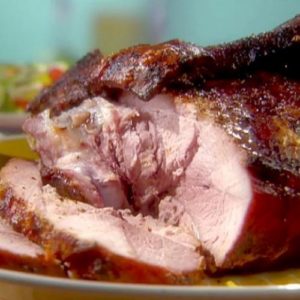
Pernil
Perhaps the best known and most coveted dish from Puerto Rico, Pernil, is a positively sumptuous preparation for pork shoulder. It’s marinated (ideally overnight) in garlic, citrus and herbs, then slow-roasted on high heat to achieve a crisp chicharrón, or skin.
Ingredients
For the Adobo:
- 8 to 9 large garlic cloves, finely minced
- 3 tbsp. olive oil
- 5 tsp. fresh sour orange juice, or equal parts lime and orange juice
- 4 tsp. dried oregano
- 8 to 9 tsp. kosher salt
- 1 tsp. black pepper
For the Pork Shoulder:
- 1 8-pound to 9-pound bone-in, skin-on pork shoulder, preferably with skin covering the entire top layer
- 1 tsp. kosher salt
Instructions
To prepare the adobo:
- Prepare the adobo by combining all the ingredients and grinding in a large pilón, or mortar and pestle, or simply mixing together well in a small bowl.
To prepare the pork shoulder:
- Rinse and dry meat well with a clean towel.
- Place pork, skin-side down, on a large rimmed sheet pan and poke deep, 1-inch holes, throughout the meat and in the fatty layer with a paring knife, being careful not to pierce the skin; you can’t have too many holes.
- Pour adobo over meat, in batches, using your fingers to push adobo deep into the meat.
- If you’re worried about your hands smelling like garlic, which they will, wear plastic gloves.
- Set out a long sheet of plastic wrap, layering with subsequent sheets, as needed, to ensure you can securely wrap the entire pork shoulder.
- Transfer pork to plastic wrap and wrap tightly, adding sheets of plastic, as needed, to ensure pork is completely airtight and juices are contained.
- Set on a rimmed baking sheet, or disposable aluminum foil pan, in case it leaks.
- Let marinate in the fridge overnight, if possible, or at least least 2 to 3 hours.
- Once the pork has marinated, pre-heat oven to 400°F.
- Working over the sink, carefully remove pork from plastic wrap, discarding any remaining adobo.
- Place the marinated pork shoulder, skin-side up in a deep roasting pan, and wipe the skin with a clean cloth.
- Rub skin with 1 teaspoon salt.
- Loosely tent foil over the pork shoulder, spraying the foil with cooking spray or brushing with oil in any areas that may touch the skin, as it will stick.
- Place on center rack in pre-heated oven.
- Roast in the oven for 1 hour; remove from oven and carefully remove the foil and rotate the pan.
- Return to oven and continue roasting for another 2 to 3 hours; rotating every hour or so, and watching closely.
- Add water to the pan, as needed, when juices evaporate.
- The meat is done cooking when the juices run clear and the thickest part of the shoulder registers 160°F with a meat thermometer.
- The skin may take more time to crisp, but watch closely so that it does not burn.
- Tap the top of the skin with the back of a knife or metal spatula, and listen for a decidedly hollow sound.
- Remove from the oven and let rest for 10 to 15 minutes; transfer to a large cutting board.
- If desired, remove the skin from the roast by slicing it along the underside of the bone with a long, sharp, slender knife; run the knife underneath the skin starting from the bottom until loosened, then lift the skin from the meat.
- Rest kitchen shears in the warm oven until ready to slice pork.
- Trim excess fat from the meat, if desired, and slice in large chunks or slices, to serve.
Notes
You can use a smaller or larger pork shoulder, but calculate your adobo accordingly by using the following formula per pound of meat: 1 large garlic clove, 1 teaspoon olive oil, 1 teaspoon kosher salt, 1/2 teaspoon sour orange juice, 1/2 teaspoon dried oregano and 1/8 teaspoon black pepper. If using a smaller pork shoulder, you may want to reduce the amount of salt slightly.
Use a pan that can handle char. You can line your pan with foil, but that can be even messier. When you’re ready to clean, combine 1/2 cup baking soda and enough hot water to cover the burned spots, and let rest for half an hour. Char should release easily with your abrasive tool of choice.